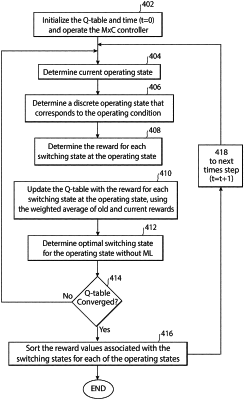| CPC G05B 19/4155 (2013.01) [G05B 13/04 (2013.01); G06N 5/02 (2013.01); G06N 20/00 (2019.01); G05B 2219/42058 (2013.01); H02M 5/00 (2013.01)] | 16 Claims |

|
1. A matrix converter system of an industrial plant system comprising:
a matrix converter having a switching matrix coupled between an input side and an output side;
a model predictive controller (MPC) configured to select a switching state of the switching matrix from a plurality of switching states, the MPC configured to:
receive an operating condition of the industrial plant system;
consult a Q-data structure to access reward values that are mapped to respective switching states of the switching matrix for an operating state that corresponds to the operating condition, wherein the Q-data structure has been trained in a real or simulation environment of the industrial plant system using Q-learning to map till convergence a reward value predicted for the respective switching states of the plurality of switching states and respective discrete operating states of a plurality of discrete operating states;
sort the reward values predicted for and mapped to the respective switching states for a discrete operating state of the plurality of discrete operating states that corresponds to the operating condition;
select a subset of the mappings as a function of a result of sorting the reward values associated with the switching states of the operating state;
evaluate by analyzing each switching state included in the subset; and
select an optimal switching state for the operating condition based on a result of evaluating the switching states of the subset, including using space vector modulation (SVM) to determine a discrete operating state of the plurality of discrete operating states that corresponds to the operating condition,
wherein the operating condition includes a multi-phase high-voltage side (HVS) voltage signal and a multi-phase low-voltage side reference voltage (LVSR) signal, and the SVM includes:
dividing the HVS voltage signal at any time instant into M even phase segments over a full cycle;
dividing phase of the LVSR voltage signal into N even sectors; and
dividing magnitude of each sector into P regions, wherein the plurality of discrete operating states includes M×N×P states.
|